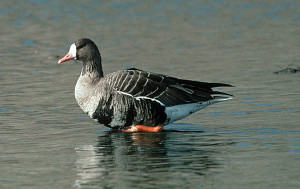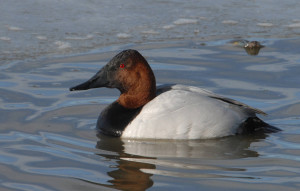Changes coming for Alabama’s waterfowl and goose seasons
Alabama’s goose hunters and youth waterfowl hunters will get increased opportunities for the 2015-2016 seasons, but Mother Nature will again determine if those opportunities are realized.
Although Alabama is not particularly known for its goose hunting, waterfowl hunters occasionally have the opportunity to add honkers to the bag. The goose season has an early segment from Sept. 26 through Oct. 13, but then the remaining goose season will run concurrently with the duck season splits Nov. 27 and 28 and Dec. 5 through Jan. 31.
“There are significant changes for goose season,” said Jud Easterwood, the Alabama Wildlife and Freshwater Fisheries Division’s District I Wildlife Supervisor and Waterfowl Project Study Leader. “I think a lot of people will be pleased with this. The seasons are now all geese for all three goose segments and both segments of the waterfowl season. If you’re planning to shoot a goose, you need to be aware of this.

Not only did the season change, so did the bag limit configuration. The daily bag limit is still an aggregate of five dark geese, but now all five of those can be white-fronted (specklebelly) geese. The aggregate bag can have no more than three Canada geese and only one Brant. Easterwood said Brant are rare visitors to Alabama. A daily bag limit of five is still in effect for the light goose species of snow, blue and Ross.
“Most hunters in Alabama are not goose hunters; they’re waterfowl hunters,” Easterwood said. “They shoot geese when they get an opportunity. Now that the seasons run concurrently, if they see a goose, they can shoot it. They don’t have to think, ‘Wait, is that in season?’ I think it’s highly beneficial that now, if you see a goose during duck season, you can shoot a goose. I think that’s just better for our hunters, much less confusing.”
For the young hunters who are 15 years old or younger, Wildlife and Freshwater Fisheries has opted to split the youth waterfowl special season. Instead of having one full weekend after the regular season is over and the waterfowl is call-shy and blind-shy, one-day youth hunts are now scheduled on November 21 and February 6, the traditional Saturday after the season.
“Now I’m excited about this,” Easterwood said. “I wish November 21 wasn’t the opening day of deer season, but this gives our young hunters a choice of deer or ducks. The U.S. Fish and Wildlife Service (USFWS) gave us the option to do this, so we thought it would be a good idea to give kids an opportunity to shoot before the regular season starts.”
If the weather pattern is similar to last year’s, early season will be the time to be in the duck blind.
“Last year I was so excited because duck numbers were up, the food production was good on the WMAs (Wildlife Management Areas) and water levels were better than average,” Easterwood said. “Everything was perfect. After that opening weekend, which was one of the best opening weekends on record, it just went south. We never really got a significant cold push for the rest of the season after that opening weekend, and it really hurt.”
The estimated duck numbers are again encouraging, but Easterwood is going to see how the weather develops before making any predictions.

“When you’re comparing from 2015 to 2014, mallard numbers are up,” he said. “Gadwalls are up. Green-winged teal are up significantly. Canvasbacks are up significantly. Blue-winged teal are about the same. A few species – wigeons, pintails and redheads – are down just a little, but overall the numbers are up. If you look at the percentage over the long-term average, that looks really good.
“And, living in Alabama, there could be a gazillion ducks north of us, but if the weather doesn’t cooperate, it doesn’t do us any good. We need snow cover as well as really cold temperatures up north to move the birds down here.”
If the weather cooperates, Easterwood said other conditions are ripe for a quality waterfowl season.
“On our WMAs, we’ve got really good crops (corn, grain sorghum and millet) at Swan Creek,” he said. “The Jackson County waterfowl areas have their best crop in five years. We’ve got plenty of natural food sources in those areas too wet to plant. Everything looks great, replete with natural foods and cultivated crops. Water conditions should be good. We’ve had decent rainfall across the state. Everything looks good right now.”
Because of Alabama’s natural habitat, the wood duck is still the waterfowl species most often found in the hunter’s bag.
“No matter where you live in Alabama, if you’ve got water, you can pretty much find a wood duck hole,” Easterwood said. “With the increasing beaver population we have, they are increasingly flooding hardwood bottoms across the state. In many areas, that’s caused a lot of problems, but it increases wood duck habitat. So, with a pretty short drive, people are able to find a wood duck hole.
“We’re still a wood duck state, but gadwalls are gaining ground. If you look at HIP (Harvest Information Program) data, some years gadwalls gets pretty close to wood ducks in annual harvest because so many gadwalls are killed in the Tennessee Valley. But the wood duck is still king.”
The daily bag limit for ducks has been tweaked a little. The liberal bag limit is still in effect with six ducks per day with no more than four mallards (only two of which may be female), three wood ducks, one mottled duck, one black duck, two redheads, two pintails, two canvasbacks, and three scaup. The possession limit is three times the daily bag limit.
Easterwood urges everybody who wants to hunt waterfowl in Alabama to obtain the Alabama 2015-2016 Waterfowl Hunting Guide either online at http://www.outdooralabama.com/sites/default/files/WaterfowlLeaflet20152016.pdf or visit a WFF office or sporting goods retailer. Easterwood said the printed version of the Alabama Hunting and Fishing Digest has incorrect information about the goose seasons and bag limits as well as incorrect information on several species of ducks.
The federal duck stamp has increased to $25 this year, the first increase since the early 90s. Easterwood hopes that doesn’t have a negative effect on waterfowl hunting participation, which has been up significantly in recent years.
“We have to go by state duck stamp sales to determine how many are hunting in Alabama,” he said. “That number has increased dramatically. It is shocking. It hung around 18,000 for years, but when ‘Duck Dynasty’ took off, it took off. We’re over 30,000 now.
“We get a lot more questions from people new to waterfowl hunting who want tips and just basic hunting advice. A lot of them are younger guys. We hope that trend continues.”
David Rainer is public information manager and outdoor columnist for the Alabama Department of Conservation and Natural Resources. His column appears weekly in The West Alabama Watchman.
